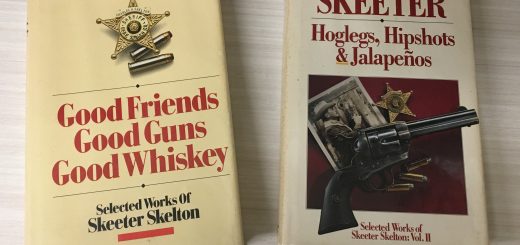The HK USP45/10
A “Gonsmiff” Story
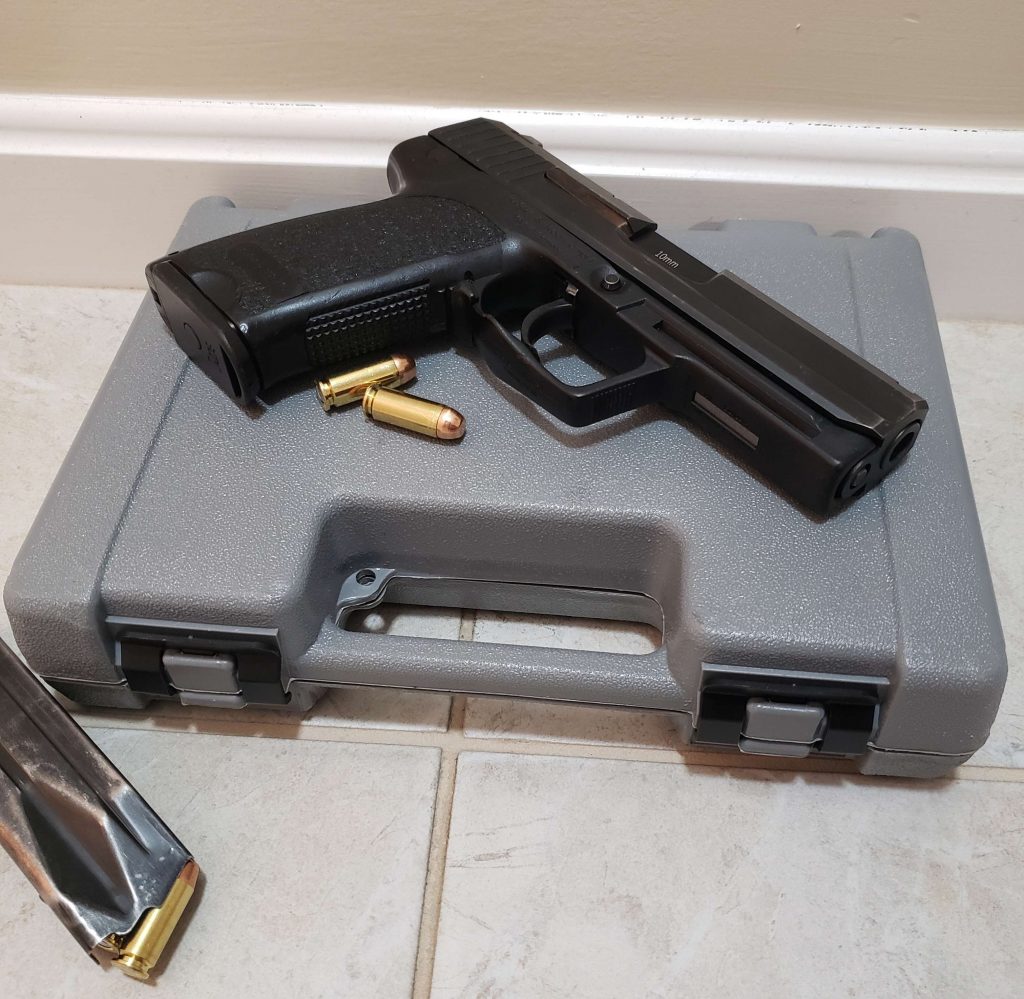
I had no intention of ever writing this article, or of ever owning a USP45, let alone converting one to 10mm. But I
did. When I walked into a new gun store and saw two identical state police trade-in USP-45s for $650, I found myself
thinking hard about purchasing one. I decided to inform my HK enthusiast (pronounced autist) friend (we all know one)
of the find and slept on it for a day.
The next day, we drove to the store to find that the pistols were still there. We proceeded to look up the date
code while we listened to the backstory of the pistols. Both pistols came from the same agency who had converted them
from the standard DA/SA Decocker to the LEM V3 trigger, both were KK production codes equating to 1999 production.
Both pistols showed plenty of wear inside and out, had nearly dead Tru Glow night sights, and came with two “LAW
ENFORCEMENT USE ONLY” mags, manual, and grey blow molded case. Obviously, we purchased them on the spot.
My friend had been looking for a cheap USP45 with the intent to convert it to 10mm for some time after he’d acquired
his first HK, a USP 9mm; it would suffice to say he was no stranger to the HKPro forums.
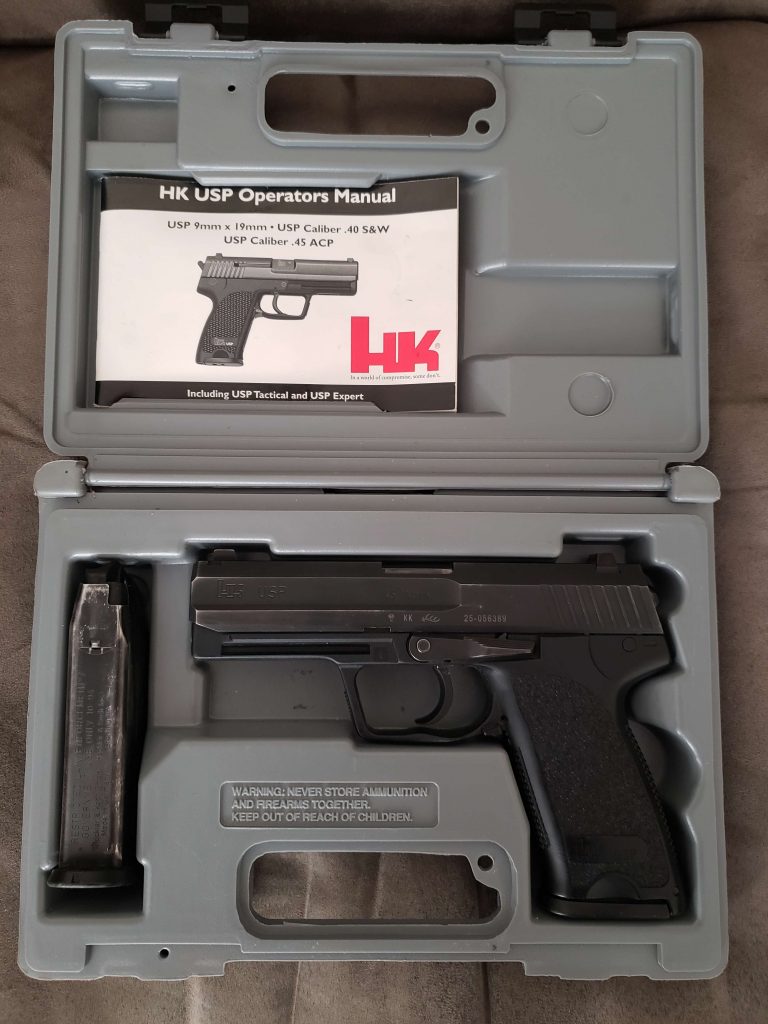
He proceeded to detail the conversion process to me during the drive back, per the HKPRO forum thread:
https://www.hkpro.com/threads/its-happening-10mm-usp-barrels-please-reserve-your-slot.389817/
Originally, my intent was to make this USP45 into a suppressor host, but my interest in a 10mm conversion grew as he
detailed his plans. I was no stranger to the cartridge, as I had a Glock 20 and had reloaded 10mm, but this project
offered a challenge and a chance to make something unique.
Per the HKPro thread, Michael’s Machines (http://michaelsmachines.com/) had made runs of different profile 10mm
USP barrels, mostly USP .40 profile, but importantly, USP 45 profile. To paraphrase the thread: Most USP 10mm
conversions have been done two ways; on a USP .40 pistol or on a USP 45 frame with a USP .40 or USP EXPERT .40 slide.
Using a USP .40 means:
1) You can’t eject an unfired 10mm round through the ejection port. You can drop the mag and let the round fall out or
you can widen the ejection port which requires refinishing of the slide (unless its stainless).
2) You can’t use HK mags
3) You need to dremel the STI mags
4) You loose last round hold open.
5) You loose the stock look because the STI mag do not mate flush with the gun.
Using a USP 45 with a USP .40 slide:
“The advantage to this method is that you can use stock .45 mags with slightly bent feed lips and you retain last round
hold open. The other big advantage is you still have a stock looking gun as far as mag fit goes. The downsides of this
conversion are:
1) You can’t eject an unfired 10mm round through the ejection port. You can drop the mag and let the round fall out or
you can widen the ejection port which requires refinishing of the slide (unless its stainless).
2) The requirement for a post-KE .40 slide and a .45 frame (essentially buying two guns to make one).
3) The .40 slide does not fully cover the end of the .45 frame. You end up with a slightly goofy looking recessed slide that
can be easily solved by sanding/trimming the .45 frame. Given that the frame is the serialized portion and that some
people will want to swap back to .45, this may not be desirable. ***This can also be resolved by using a .40 expert slide.”
The post ends with a caveat about the final untested method of conversion:
“Given the revelations from conversion method #2, much interest has been generated in a 10mm barrel that would drop
into a complete .45 gun. This would solve all of the downsides of methods #1 and #2 but it has never been done before,
so it is very experimental. Possible issues here are extractor issues, firing pin alignment issues etc… I have not checked to
see if a .40 extractor can be mounted in a .45 slide, so custom work may be required to get a functioning conversion.
Mike mentioned he can manufacture extractors as well but that would be a separate endeavor. I would not recommend
this route unless you are happy to be a guinea pig and potentially waste $350.”
I proceeded to contact Michael’s Machines and had a pleasant conversation, during which, he informed me that he did
not intend to make another run of 45 profile barrels and all he had remaining were the 45 profile barrels that were
mistakes. The rear lug had been machined to fit a .40 slide, but all other dimensions were machined to fit a .45 slide.
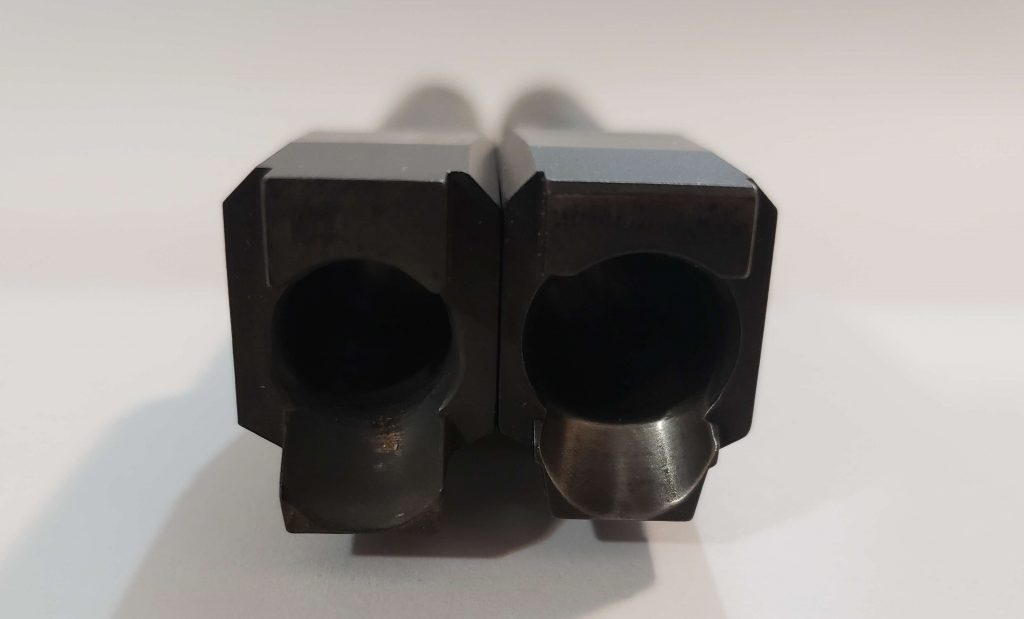


Undeterred, I asked if he would still sell me the barrels, to which he agreed at $175, and providing I sign a liability
waiver. Two waivers and $350 later, the heart of our conversions were on their way; arriving promptly in two days.




Upon installing the barrels, I noted them to be .003-.005 larger than the factory .45 barrels making for a tight fit. Prior to
this point, I had test fired my pistol and found it to cycle .45 reliably, but it was evident that the springs were tired. The
10mm has about half the hood engagement height.
I proceeded to test feeding 10mm snap caps through the unmodified mags into the gun and found that the extractor
wouldn’t allow the rims to slide under it. I also discovered that it would not fully extract the snap caps, as the base of the
snap cap was driven leftward out of its grip due to the magazine follower. It would fully extract every other round due to
the left-right stacking bias of the cartridges presenting from the magazine.


I decided that this necessitated modification of the extractor, as I did not want to permanently modify parts I couldn’t
replace. The circled portion of the extractor acts as an overtravel stop against the frame, and as such, it needed to be
removed in order to allow the extractor to control the cartridge rim throughout the extraction and ejection sequence.



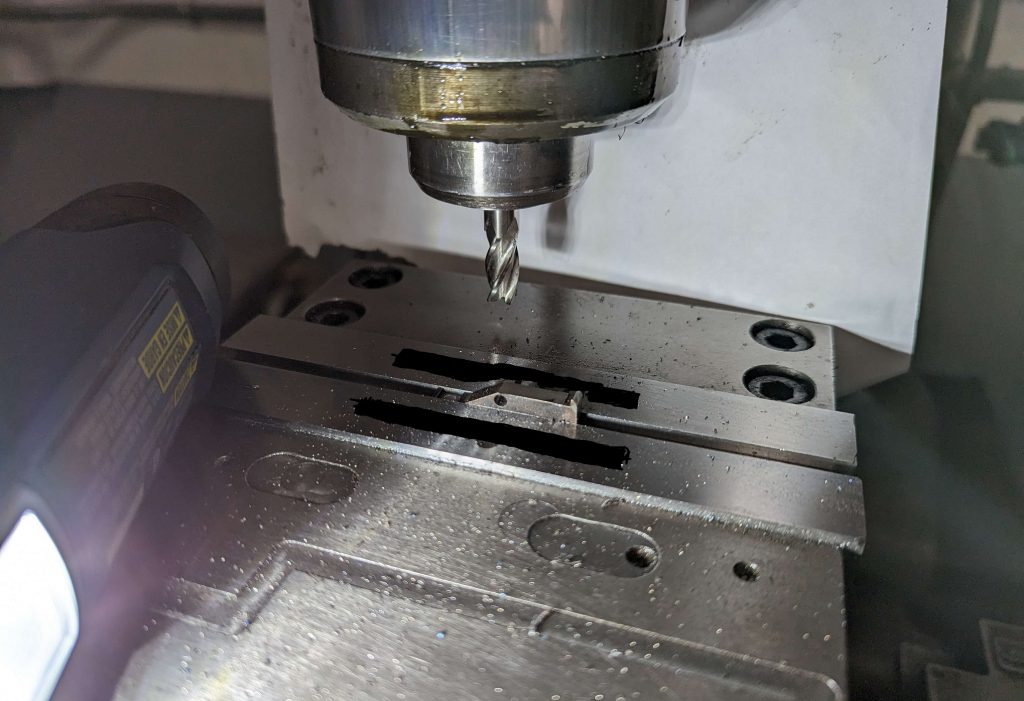
After initial dremeling and finish milling, I attempted feeding again, and again, the rims were jamming against the
extractor when feeding from the magazine; but the cartridges would fully extract. You can see how much further in the
extractor sits in the photos below, as evidenced by the brass left by a fired 10mm inside the diameter of previously fired
.45ACP:


I examined the extractor and decided that it had too blunt a profile; the brass was hitting a flat surface and not the angle
on the edge of the extractor claw.
Factory new left, modified on the right:
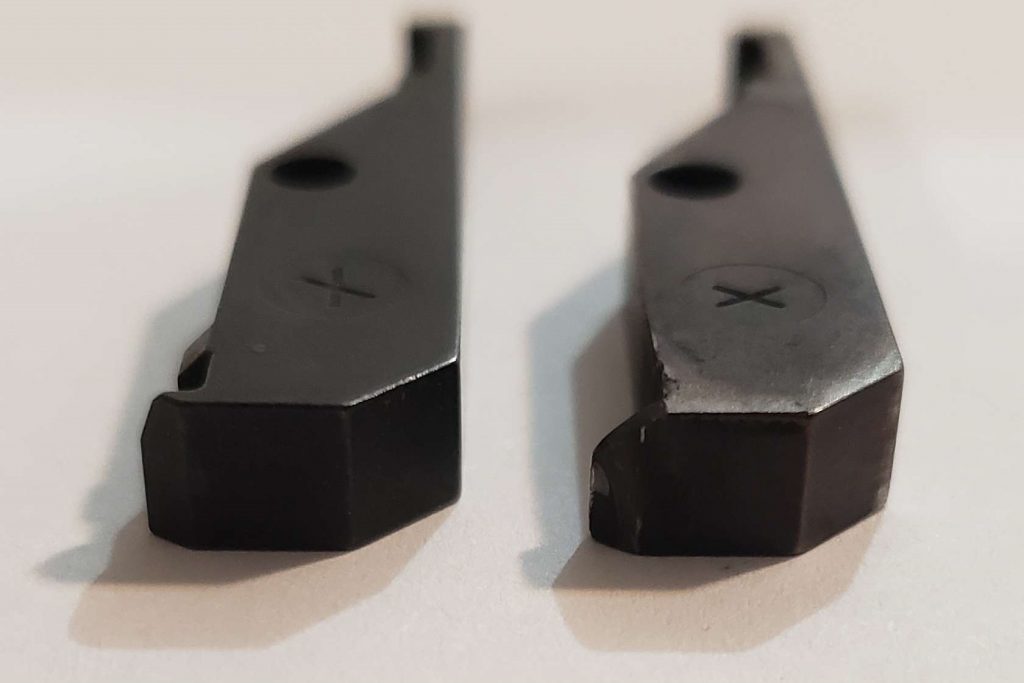
I dremeled what I estimated to be the proper angle, fitting and checking several times until it fed properly. I had also
ordered a 20lb recoil spring and magazine springs from Wolff Springs to replace the tired originals. Note: it is easiest to
“unthread” the recoil spring from the guide rod by slipping it over the retaining washer instead of removing the E-clip
(although you may wish you had done so when you discover that getting the final coil of the spring behind the washer
requires the use of a third arm).

Having met with success, I proceeded to the range with both barrels, standard .45 ACP ammunition, and both weak and
proper 10mm factory loads.

The PPU 10MM JHP, reportedly chronos at 850-900fps, probably the slowest 10mm you can find, whereas the SIG 180gr
hit a respectable 1250fps (proper original 10mm is 180gr @1300fps from a 5” barrel).
First, I tried the original .45 ACP barrel and had no problems feeding or cycling 230gr FMJ with the modified extractor or
heavier recoil spring. I swapped the barrel and loaded the magazine with the PPU ammo first; one magazine seemed to
cause failures to feed due to the feed angle and a tight chamber. After a successfully avoiding Glocknading myself with
weak 10mm, I loaded the full power SIG ammunition. I was able to fire once and was greeted with the sight of spent
brass and a live cartridge ejecting from the pistol; when I pulled the trigger again, the hammer fell on an empty
chamber. I racked another cartridge in and fired, this time a live cartridge wedged itself vertically between the breech
face and barrel.

Signaling that the magazine feed lips needed more tension, I concluded the range session. The magazines would hold
15rds of 10mm without modification of the feed lips or follower; however the angle of presentation for the cartridges
was too high and too loose. I could eject round from the mags by slamming them on a table or inserting them forcefully
into the pistol. I had previous experience bending feed lips when I accidentally purchased 10rd .40 Hi Power mags and
bent the feed lips to accommodate 13rds of 9mm. Using Glock 20 magazines as a reference, I measured them at .375” in
width, and proceeded to squeeze the HK magazine feed lips in a vice. I stopped squeezing when the width read .385” or
just over 3/8”; verifying by aggressively seating the mags and chambering with the slide release. I found that using the
slide release was a better test of fitment, as it would cause a failure to feed where sling-shotting the slide would not.
Once more venturing to the range, I had no further issues feeding or ejecting live cartridges, so I loaded up some
Underwood and let loose with five fireballs.
It is notable that the firing pin did not strike the direct center of the primer, but it is no further off center than some
factory pistols I have seen.
I have put 100rds through this conversion, and I intend to continue refining it. I hope you enjoyed this kitchen table
gunsmithing adventure into the forbidden HK USP CENTIMETER!
